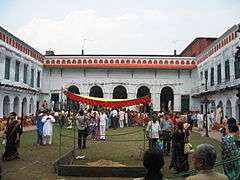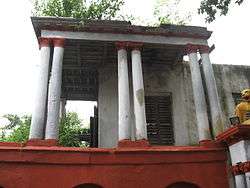Nabakrishna Deb
| Nabakrishna Deb | |
|---|---|
| Born | 1733 |
| Died |
1797 Kolkata |
| Known for | Aristocrat, Treachery |
Nabakrishna Deb (better known as Raja Nabakrishna Deb, archaic spelling Nubkissen) (1733–1797), founder of the Shovabazar Raj family, was instrumental in the plot against Nawab Siraj-ud-Daula. He has been called the greatest Hindu traitor[1] of India, who enabled the British to rule India for 200 years.[2] He is known for the Durga Puja he organised in the newly constructed Shobhabazar Rajbari (king's palace) in Kolkata (then Calcutta) in 1757, as a patron of numerous performing artistes, and his philanthropy.[3]
Early life
Nabakrishna Deb lost his father, Ramcharan Deb, early in life but his mother took care to ensure that he learnt Urdu and Persian initially and later Arabic and English. Deb was appointed Persian teacher of Warren Hastings in 1750. At one point of time he was munshi (clerk-cum-interpreter) of Governor Drake, advised the British on foreign relations and was a great supporter for the establishment of British power in India. He had carried out confidential work for the British East India Company, prior to and during the Battle of Palashi. After the death of Siraj ud-Daulah, Deb along with Mir Jafar, Amir Beg and Ramchand Roy earned eight crore rupees worth of treasures from the secret treasury.[3]
Achievements
Durga Puja
After his victory in the Battle of Palashi, in 1757, which laid the foundation for British rule in India, Lord Clive wanted a grand thanksgiving ceremony but the only church in Kolkata had been razed to the ground by Siraj ud-Daulah, during his attack a year earlier. When Deb came to know of Clive's desire, he advised, "Offer your thanks at the goddesses' feet at my Durga Puja.” “But I am a Christian," protested Clive.
“That can be managed," smiled the wily Deb.
Lord Clive drove in his carriage all the way from his residence in what was then known as New Town (part of the city where the British people used to live) of Kolkata to Shovabazar in the Old Town (where the natives used to live), for the Durga Puja. Thereafter, it came to be known as the "Company Puja".[4]
Deb set a pattern for the puja which became a fashion and a status symbol among the upcoming merchant class of Kolkata. The number of Englishmen attending the family Durga Puja became an index of prestige. Religious scruples fell by the wayside.The Englishmen attending the dance-parties, dined on beef and ham from Wilson's Hotel, and drank to their heart's contentment.[4]
While barowari (community) pujas subsequently took over in a big way, the Durga Pujas of the old zemindar families in and around Kolkata still attract crowds. Shovabazar Rajbari organised the 250th Durga Puja in 2006.[5]
Later life
With Lord Clive backing him, Deb earned the title of Maharaja Bahadur in 1766. The position offered him some administrative powers also. Later he became a political banyan (a powerful middleman) of the British East India Company. When Warren Hastings took over as governor (Governor General of Fort William in Bengal) in 1772, he became even more powerful. In 1776, he earned the talukdari (landholder with peculiar tenure) of Sutanati.[3]
It is one of the inevitable results of a foreign occupation that the history of modern India as written by Englishmen – and no one else has cared to write it – takes little account of the Indian helper whose aid has been essential, and whose advice and knowledge has been invaluable, to the men who built up the fabric of English rule. Nowhere, perhaps is this reticence or history more marked than in the case of Maharaja Nubkissen, the friend and counsellor of Clive and Hastings who beginning life as the Persian tutor of the latter, rose to be the Company's interpreter and crowned career as their political banyan. Mill makes no reference to him: Orme does not mention him, and his name is absent from the pages of Sir John Malcolm. Yet he was no ordinary man, and the influence and power wielded by him during the thirty years which precede his death in 1797 was extraordinarily large.[6]
It is beyond reasonable doubt that along with Mir Jafar and Jagat Sheth; Nabakrishna Deb played a crucial role in turning India to a British colony. In reality, he was the main ally of Clive and a British agent whose shameless actions as a traitor led to the establishment of British rule in India, and ensuing sacrifice and lives of thousands of freedom fighters.[7]
He created a sensation in those days by spending Rs. 1 million (1 million) for the sraddha (the last rites ceremony by Hindu tradition) of his mother, feeding the poor, honouring the learned, and doing everything on a grand scale. He constructed the 50 km (31 mi) road from Behala to Kulpi (presently in South 24 Parganas district) in what was then jungle territory.[3]
He organised a conference of learned men in his Rajbari and patronised many musicians. Harekrishna Dirghangi, Nitai Baisnab and other kabials enjoyed his hospitality. He donated to different causes irrespective of religious denominations. He gave money to start the Calcutta Madrasa, donated land for St.John's Church and earned a reputation as a philanthropist.[3]
Family
He left behind two sons, one adopted and the other his own begetting. His adopted son, Gopi Mohun Deb (Raja) was famous for his musical taste. His natural born son was Rajkrishna Deb (Raja). He had one grandson on the adopted side – Radhakanta Deb (Raja, Sir). His natural born son was father of eight distinguished sons, prominent among whom were Kali Krishna Deb (Raja Bahadur), Kamal Krishna Deb (Maharaja) and Narendra Krishna Deb (Maharaja Bahadur, Sir). All of them, and some others belonging to subsequent generations in the family, have roads named after them in Kolkata.
Shobhabazar Rajbari
Raja Nabakrishna Deb (1737–97) founder of the Shobhabazar Rajbari, started life modestly but soon amassed considerable wealth in his service to the British, in particular by his role in assisting to topple Siraj ud-Daulah. During his lifetime Raja Nabakrishna Deb built two houses. The building at 33 Raja Nabakrishna Street, on the northern side of the road, was the one first constructed by him, subsequently given over by him to his adopted son Gopimohan. The house at 36 Raja Nabakrishna Street was built by him when a son was born to him later in life and was left to his natural son Rajkrishna and his descendants.
Gallery
 Thakurdalan at Shobhabazar Rajbari
Thakurdalan at Shobhabazar Rajbari Singh Dwar (Lion gate) at Shobhabazar Rajbari
Singh Dwar (Lion gate) at Shobhabazar Rajbari Natmandir at Shobhabazar Rajbari
Natmandir at Shobhabazar Rajbari
See also
References
- ↑ http://epaper.sangbadpratidin.in/epaper/edition/445/sangbad-pratidin-19-09-16/page/4
- ↑ https://www.quora.com/What-would-have-happened-if-the-British-never-came-to-India#!n=108
- 1 2 3 4 5 Sengupta, Subodh Chandra and Bose, Anjali, Sansad Bangali Charitabhidhan (Biographical dictionary) (Bengali), Vol I, 1998 edition, p 242. ISBN 81-85626-65-0
- 1 2 Jaya Chaliha and Bunny Gupta, Durga Puja in Calcutta in Calcutta The Living City Vol II, edited by Sukanta Chaudhuri, Oxford University Press, first published 1990, paperback edition 2005, pp 332–333. ISBN 0-19-563697-X
- ↑ Mukherjee Pandey, Jhimli (30 September 2006). "Shobhabazar Raj Bari". Family tradition alive in the City of Joy. Times of India. Retrieved 18 February 2007.
- ↑ Cotton, H.E.A., Calcutta Old and New, 1909/1980, p288-289, General Printers and Publishers Pvt. Ltd.
- ↑ http://www.dnaindia.com/lifestyle/report-durga-puja-s-colonial-roots-1754517